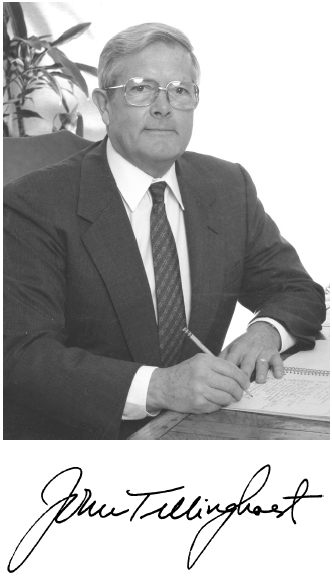
1927–2011
Elected in 1974
“Leadership in the development and utilization of advanced systems of generation and transmission.”
BY JAMES J. MARKOWSKY
JOHN A. TILLINGHAST, a leader in the development and implementation of advanced power generation cycles and high-voltage transmission systems, died on May 7, 2011, at the age of 84.
John was born in New York City to Charles C. and Dorothy Tillinghast. He attended the Horace Mann School, where his father was headmaster, and then studied at Columbia University while serving in the US Navy V-12 program (from 1944 to 1952). In 1948 and 1949 he earned BS and MS degrees, with honors, in mechanical engineering.
Upon graduating he was hired by American Electric Power Service Corporation (AEP), where his career spanned 30 years. As a young project engineer, he was involved in the first supercritical steam-generating unit in the United States. Soon identified as an up-and-coming engineer, in 1953–1961 he participated in the study, R&D, and construction of the first 345 KV and 765 KV high-voltage transmission systems, and in 1958 he led an R&D study by ten electric utilities to design the first magnetohydrodynamic power plant. He quickly rose at AEP to become chief mechanical engineer, chief engineer, and in 1967 executive vice president of engineering and construction.
The 1960s were a technically exciting time at AEP, and John’s technical capabilities and curiosity were the driving force in his direction of studies for the next generation of supercritical fossil and nuclear reactors along with implementation of the 765 KV transmission system. From 1967 to 1975, he directed the planning, engineering, purchase, and construction of 10,000 MWe plants, which included five double-reheat 800 megawatt (MW) and three single-reheat 1,300 MW supercritical pressure coal units (the largest in the world), and two 1,100 MW pressurized water reactor nuclear units along with the installation of 1,400 miles of 765 KV high-voltage transmission.
His technical and professional curiosity also drove AEP to pursue enhancement in both power generation and ultra-high-voltage transmission technology. The resulting enhancements include the establishment of development programs for 2,000 KV ultra-high-voltage transmission and a pressurized fluidized bed combustion combined cycle.
In 1972 he was elected director of American Electric Power Co., the parent holding company, and in 1975 vice chairman of the board in charge of engineering and construction, a position he held until his retirement in 1979.
When he left AEP he joined Wheelabrator Frye Inc. as senior vice president of technology. He also held various executive positions in the Allied Advanced Technology Group, Allied Signal International, Science Applications International Corp., TITEC, Great Bay Power Corp., BayCorp Holdings Ltd., and served on the board of directors of Cogentrix Energy, Inc. In these activities John’s professional knowledge and expertise spanned alternative energy projects, cogeneration, and other innovative technologies, and he holds a patent for a generative unit control system.
In addition to his election to the National Academy of Engineering, John was a fellow of the American Society of Mechanical Engineering. He also gave generously of his time to support nonprofit and professional organizations. He chaired the National Research Council (NRC) Energy Engineering Board (1986–1993), and served on the NRC Commission on Engineering and Technical Systems and Committee on
Alternatives to Indian Point for Meeting Energy Needs. He was an Elder of the reformed Church of Bronxville, New York, and a member of the United Church of Christ of North Hampton, New Hampshire.
John was a devoted husband and father. He was predeceased by his wife of 52 years, Mabel, and grandson Steven Ryan. He is survived by daughters Katherine Brickley and husband John of Hampton, New Hampshire; Susan Trainor and husband John of Rye, New Hampshire; and Abigail Ryan and husband Sidney of Chesapeake, Virginia; grandchildren Christopher Ryan and wife Tara, Kathleen Trainor, John Trainor, and Sarah Brickley; great-grandchild Shawn Ryan; his brother David of New York City; several nieces and one nephew.
John’s faith and strength of character made him a trusted friend, advisor, and mentor to many. He will be greatly missed.




